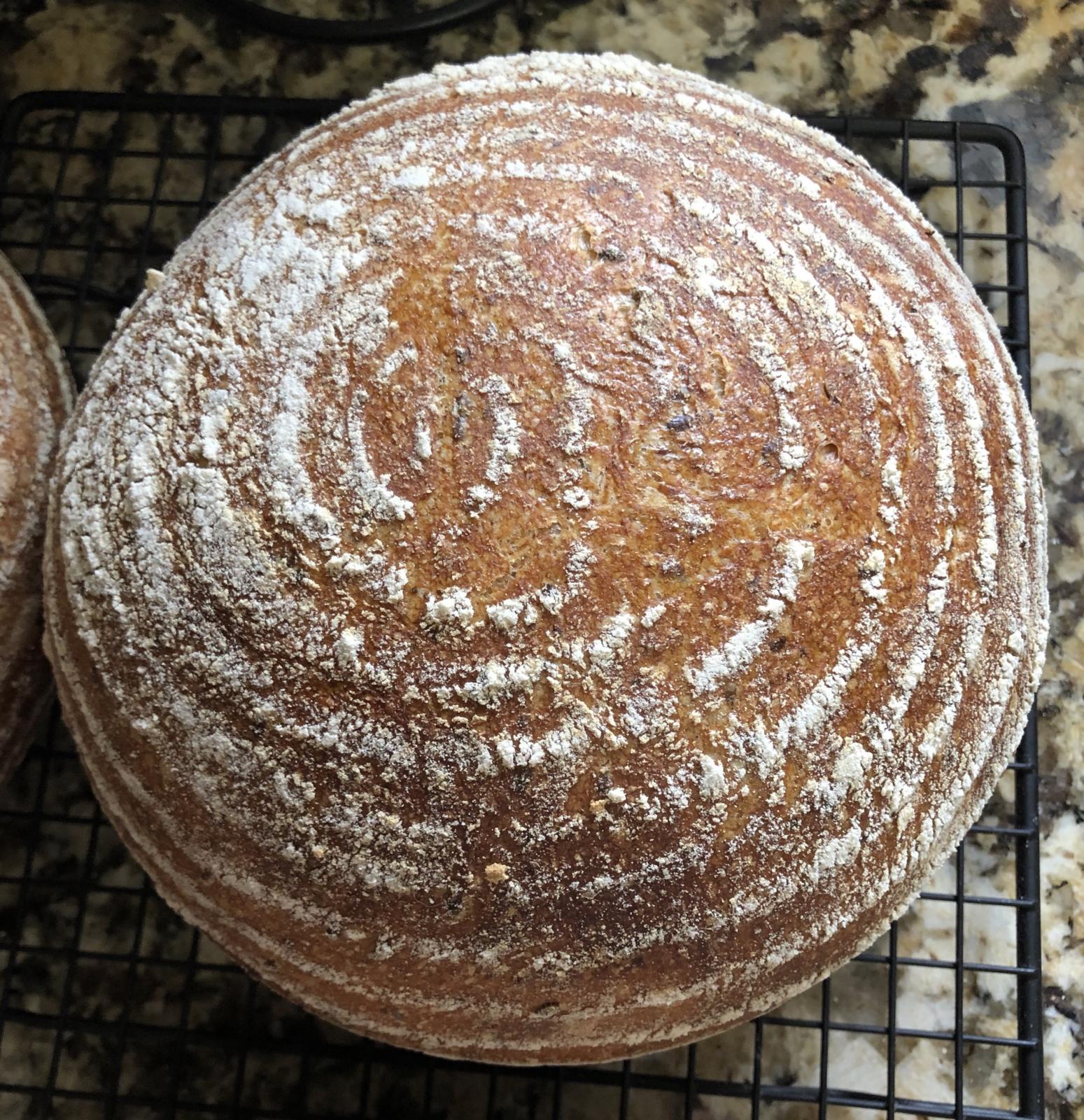
Spelt Kamut Peasant Bread

This is basically a Pain de Campagne but with a bit more whole grain. I figured that a fairly plain loaf, meaning no add-ins aside from the flax, would go well with an Easter Dinner meal.
Recipe:
Makes 3 loaves
150 g high extraction spelt flour (200 g Spelt berries)
150 g high extraction rye flour (200 g rye berries)
150 g high extraction Kamut flour (200 g Kamut berries)
820 g unbleached flour
50 g freshly ground flax (50 g flax seeds)
950 g filtered water
24 g Himalayan pink salt
30 g local yogurt
250 g 100% hydration levain (procedure for this is in recipe)
The afternoon before:
- Mill the Spelt , Rye and Kamut berries and sift to obtain the needed amount of high extraction flours. Place the required amounts in a tub. Save the bran for feeding the Levain and for another use such as bran muffins. Reserve any leftover high extraction flour for feeding the Levain in the evening and the next day.
- Add the unbleached flour to the tub.
- Ground the flax seeds in a bullet and add to the tub. Cover and set aside.
- Take 18 g of refrigerated starter and feed it 18 g of filtered water and 18 g bran. Let rise in a warm place.
The night before:
- Before going to bed, feed the levain 36 g of water and 36 g high extraction flour. Let that rest in a warm spot overnight.
Dough making day:
- Early in the morning, feed the levain 72 g of filtered water and 72 g of high extraction flour/AP flour and let rise 4-5 hours in a warm spot.
- Two hours or so before the levain is ready, put 950 g filtered water in a stand mixer’s bowl and add the flours from the tub. Mix on the lowest speed until all the flour has been hydrated. This takes a couple of minutes. Autolyse for at least a couple of hours at room temperature.
- Once the levain is ready, add the salt, the yogurt and the levain to the bowl. Mix on the lowest speed for a minute to integrate everything, then mix on the next speed for 5 minutes.
- Remove dough from bowl and place in a covered tub. Let rest 30 minutes at room temperature (73F).
- Do 4 sets of stretches and folds at 30 minute intervals, then do two more sets on hourly intervals. Immediately after the last fold, place the dough in the fridge for 4 hours. The dough almost doubled.
- Tip the dough out on a bare counter, sprinkle the top with flour and divide into portions of ~860 g. Round out the portions into rounds with a dough scraper and let rest 60 minutes on the counter.
- Do a final shape by flouring the rounds and flipping the rounds over on a lightly floured counter. Gently stretch the dough out into a circle. Pull and fold the third of the dough closest to you over the middle. Pull the right side and fold over the middle and do the same to the left. Fold the top end to the center patting out any cavities or big bubbles. Finally stretch the two top corners and fold over each other in the middle. Roll the bottom of the dough away from you until the seam is underneath the dough. Cup your hands around the dough and pull towards you, doing this on all sides of the dough to round it off. Finally spin the dough to make as tight boule as you can.
- Sprinkle half rice/half AP flour in the bannetons. Place the dough seam side down in the bannetons. Cover with plastic bowl cover or shower caps. Let rest for a few minutes on the counter and then put to bed in a cold (38F) fridge for 9-10 hours.
Baking Day
- The next morning, heat the oven to 475F with the Dutch ovens inside for 45 minutes to an hour. Then take the loaves out of the fridge. Turn out the dough seam side up onto a cornmeal sprinkled counter. Place rounds of parchment paper in the bottom of the pots, and carefully but quickly place the dough seam side up inside.
- Cover the pots and bake the loaves at 450 F for 30 minutes, remove the lids, and bake for another 17 minutes at 425 F. Internal temperature should be 205F or more.

Oops! They hit the lid so the tops are flat. That will probably affect the crumb. ?I need to remember to use less flour next time!


Comments
that steam helps oven spring, here you go! I took the lid off about 10 minutes into the bake to see what would happen. The loaf rose but didn’t get any ears. Even with hitting the lid, all the other loaves developed the characteristic cracks that I guess have become my signature. Note that I bake with the fan on to prevent burning of the bottoms so that might have helped set the crust as well.
And here is the crumb. Would have been better if it hadn’t been squished against the lid.
I baked some of this too, with the exception of using Einkorn instead of Kamut because that is what I had. They were very springy loaves, they rose a lot during the bulk ferment and I had worried that they were over proofed, but I got great oven spring too. The flavour is great, a little sour, a little rye comes through. This may end up being a staple in our house. (oh I also threw in a tbl each of chia and hemp seeds for protein - can't taste them or see them so its perfect)